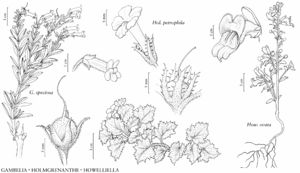Holmgrenanthe petrophila
Syst. Bot. Monogr. 5: 54. 1985.
Plants 5–12 cm, cespitose. Stems brittle. Leaves: petiole 12–27 mm; blade orbiculate to reniform, 12–35 × 14–27 mm, apex spinulose. Pedicels ascending, 1–4 mm, glandular-puberulent to glandular-villous. Flowers: sepals falcate, 9–13 × 2–3 mm, margins spinulose, glandular-villous; corolla tube 20–24 mm, glandular-villous, throat open, palate not inflated, abaxial plicae dark yellow with ligulate hairs; lobes: abaxial projecting, adaxial erect, equal, rounded, 7–12 mm; stamens included, filaments incurved, yellow at base, abaxial 12–14 mm, adaxial 7–9 mm, pollen sacs oblong; ovary with a T-shaped septum; style included, terete, 9–10 mm, stigma recurved. Capsules globular, 8–10 mm. Seeds 2–3 mm, surface foveolate.
Phenology: Flowering Apr–Jun.
Habitat: Calcareous canyon walls.
Elevation: 700–1800 m.
Distribution
Calif.
Discussion
Holmgrenanthe petrophila is known from the limestone walls of Fall and Titus canyons in the Grapevine Mountains in Death Valley National Monument, Inyo County.
Selected References
None.
